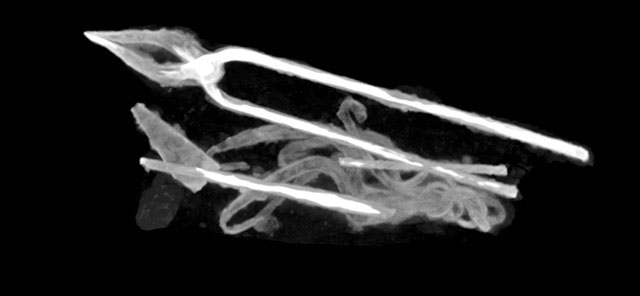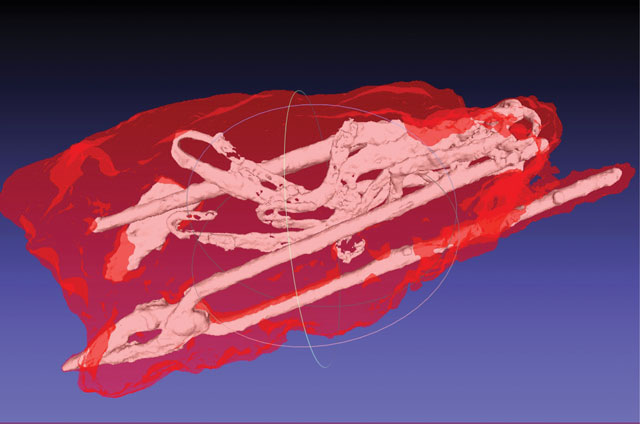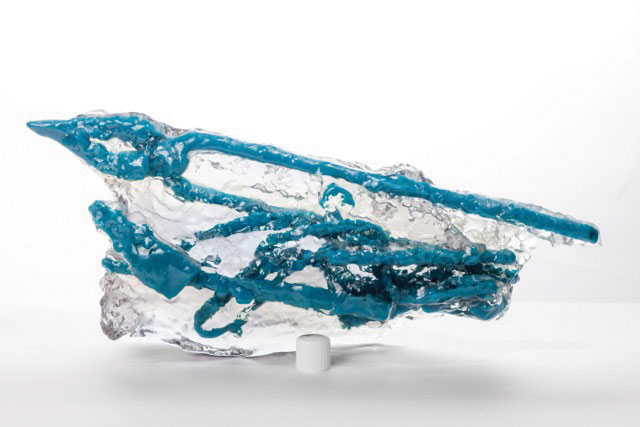by Théophane Nicolas (Inrap/UMR 8215 Trajectoires), Ronan Gaugne (Université de Rennes 1/IRISA-Inria) and Valérie Gouranton (INSA de Rennes/ IRISA-Inria) and Jean-Baptiste Barreau (CNRS/CReAAH UMR 6566)
Traditionally, accessing the interior of an artefact or an archaeological material is a destructive activity. We propose an alternative non-destructive technique, based on a combination of medical imaging and advanced transparent 3D printing.
Our project proposes combining a computed tomography (CT) scan and advanced 3D printing to generate a physical representation of an archaeological artefact or material. This project is conducted in Rennes, France, with archaeologists from Inrap [L1] and computer scientists from Inria [L2]. The goal of the project is to propose innovative practices, methods and tools for archaeology based on 3D digital techniques.
Archaeologists and curators regularly experience the problem of needing to work on objects that are themselves or have features which are inaccessible. For example, artefacts may be encased in corroded materials or in a cremation burial, or integrated in, and inseparable from, larger assemblies (e.g., manufactured objects with several components). Current archaeological processes to analyse concealed or nested archaeological material often use destructive techniques. On the other hand, the absence of a real understanding of the internal structure or state of decay of some objects increases the risk that investigation could destroy source material.
CT scan is an imaging technology based on X-rays mostly used for medical purposes. It produces images of the internal structure of the scanned objects with density information about the internal composition. This technology is increasingly used in Cultural Heritage (CH) to obtain images of the internal structure of archaeological material. However, it remains mainly limited to providing 2D images.
We propose a workflow where the CT scan images are used to produce volume and surface 3D data which serve as a basis for new evidence usable by archaeologists. This new evidence can be observed in interactive 3D digital environments or through physical copies of internal elements of the original material, as in [1] and [2].
This workflow has been applied to a block of corroded Iron Age tools discovered in Plumaugat [L3], Brittany, France (Figure 1) during excavations conducted by E. Ah Thon, Inrap. The CT scan of the block revealed an assembly of several blacksmith tools (Figure 2). The resulting DICOM data was processed with the Osirix software in order to generate 3D models of the metal tools and of the external shape of the block (Figure 3). These 3D models were then processed and 3D printed with an emerging 3D printing technique mixing coloured and transparent parts (Figure 4).

Figure 1: The original block excavated from the site of Plumaugat.

Figure 2: View of the internal structure of the block with CT scan.

Figure 3: 3D models of the external shape and the internal tools.

Figure 4: 3D printing of the block.
The resulting object is a 1:1 physical representation of the initial object that gives access to the internal spatial organisation of the components. The tangible medium allows for physical manipulation and simple visualisation to support researchers’ analysis, as well as aiding the excavation process as such. Having such representations available offers the possibility of taking immediate precautionary measures before any manual intervention; such representations are also the only tangible medium of context preserved after the excavation of the original material. Furthermore, it is important to note that the workflow process presented here is far quicker than a current excavation and restoration processes as presented in [3].
The workflow presented in this paper is currently developed and extended through collaboration with the Canadian INRS and University of Laval, within the ANR-FRSCQ project INTROSPECT [L4]. This project, which started in January 2017, aims to develop digital interactive introspection methods for archaeological material. These methods will combine CT scan with 3D technologies such as virtual and augmented reality, tangible interactions, and 3D printing.
Thanks to the interdisciplinary collaboration, the INTROSPECT project aims to provide innovative solutions with new usages and tools to allow access to new knowledge for archaeologists and CH practitioners. The project is based on real use cases corresponding to actual archaeological problems. The scientific heart of the project is the systematisation of the relation between the object/artefact, the archaeological context, the digital object, the virtual reconstruction of the archaeological context, as well as the physical copy obtained with 3D printing.
Links:
[L1] www.inrap.fr
[L2] www.inria.fr
[L3] https://kwz.me/hnL
[L4] introspect.info/
References:
[1] T. Nicolas, et al.: “Preservative Approach to Study Encased Archaeological Artefacts, Int. Conf. on Cultural Heritage, LNCS, Vol. 8740, pp. 332–341, 2014.
[2] T. Nicolas, et al.: “Touching and interacting with inaccessible cultural heritage, in Presence: Teleoperators and Virtual Environments”, MIT Press, 2015, 24 (3).
[3] T. Nicolas, et al.: “Internal 3D Printing of Intricate Structures”, Int. Conf. on Cultural Heritage, LNCS, Vol. 10058 (Part I), pp.432-441, 2016.
Please contact:
Valérie Gouranton
INSA de Rennes/ IRISA-Inria, France,
Théophane Nicolas, Inrap/UMR 8215 Trajectoires, France
Jean-Baptiste Barreau
Jean-Baptiste Barreau, CNRS/ CReAAH UMR 6566, France










